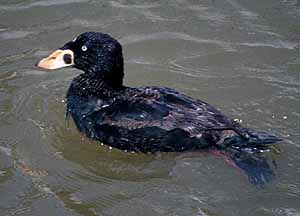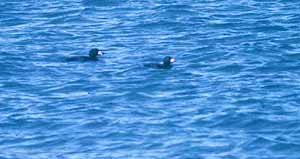MISIDENTIFICATION #4: "BLACK SCOTER"
 Unfortunately this particular photo does not illustrate well what is a
real problem. This young male Surf Scoter (left) already has a classic
Surf Scoter bill, so is not likely to be misidentified, but I use this
photo because its the best I have so far, and it does show that young male
Surf Scoters may lack any hint of white on the nape well into spring (this
photo in April). Every fall and winter "Black Scoters" are reported in
Monterey Bay that are young male Surf Scoters just getting yellow or orange
color to the base of the bill, and often are compared to more obvious male
Surf Scoters. These birds are usually seen with a scope at a fair distance.
Way too much emphasis is placed on color and pattern by beginning &
intermediate observers to the exclusion of the much better clues provided
by shape. The bill of Surf Scoter is always broad and expansive and merges
into the forehead without much demarcation. The forehead itself is sloping
and the head shape blocky.
Unfortunately this particular photo does not illustrate well what is a
real problem. This young male Surf Scoter (left) already has a classic
Surf Scoter bill, so is not likely to be misidentified, but I use this
photo because its the best I have so far, and it does show that young male
Surf Scoters may lack any hint of white on the nape well into spring (this
photo in April). Every fall and winter "Black Scoters" are reported in
Monterey Bay that are young male Surf Scoters just getting yellow or orange
color to the base of the bill, and often are compared to more obvious male
Surf Scoters. These birds are usually seen with a scope at a fair distance.
Way too much emphasis is placed on color and pattern by beginning &
intermediate observers to the exclusion of the much better clues provided
by shape. The bill of Surf Scoter is always broad and expansive and merges
into the forehead without much demarcation. The forehead itself is sloping
and the head shape blocky.

Two real Black Scoters (adult males) are shown at right. They
have small, thin bills with a big yellow bulb at the base of the upper
mandible (not a bulbous whole bill). It is easy to distinguish bill from
crown, and the forehead and entire head is very round in shape. All these
points are shown in standard field guides, yet observers may this error
every year.
Females are also sometimes misidentified. There is variation in the
extent of white on the faces of female Surf Scoters, and sometimes white
patches seem to "merge" into a white cheek patch, suggesting the pattern
of female Black Scoter. Again, bill and head shapes are critical, but rarely
noted.
Surf Scoters are very common in winter around Monterey Bay, and some
non-breeders remain to summer each year. Black Scoter is quite scarce,
especially in recent decades. Usually just 2-5 birds are found each winter,
typically inside Moss Landing harbor, around the wharves in Monterey harbor,
or in the big scoter flocks off Ft. Ord. Monterey Bay seems to be at about
the southern edge of regular winter distribution in Black Scoter. More
birds were present during "cold water" years in the 1960s and 1970s, but
in the "warm water" 1980s and 1990s, they became scarcer. If "cold water"
regimes return, we may see more again, but beware the problem of young
male Surf Scoters.
PHOTOS: The immature male Surf Scoter
was
at Moss Landing, Monterey Co., in Apr 1998; the male Black
Scoters were photographed by J. Van Remsen, Jr., off Pt. Reyes,
Marin Co., in Nov 1973. Photos © D. Roberson and J.
Van Remsen, Jr., respectively.
TOP
BACK TO TEN
MOST MISIDENTIFIED PAGE
GO TO MONTEREY PAGE
GO TO
IDENTIFICATION PAGE
GO TO HOME PAGE
GO TO LIST OF BIRD
FAMILIES OF THE WORLD
 Unfortunately this particular photo does not illustrate well what is a
real problem. This young male Surf Scoter (left) already has a classic
Surf Scoter bill, so is not likely to be misidentified, but I use this
photo because its the best I have so far, and it does show that young male
Surf Scoters may lack any hint of white on the nape well into spring (this
photo in April). Every fall and winter "Black Scoters" are reported in
Monterey Bay that are young male Surf Scoters just getting yellow or orange
color to the base of the bill, and often are compared to more obvious male
Surf Scoters. These birds are usually seen with a scope at a fair distance.
Way too much emphasis is placed on color and pattern by beginning &
intermediate observers to the exclusion of the much better clues provided
by shape. The bill of Surf Scoter is always broad and expansive and merges
into the forehead without much demarcation. The forehead itself is sloping
and the head shape blocky.
Unfortunately this particular photo does not illustrate well what is a
real problem. This young male Surf Scoter (left) already has a classic
Surf Scoter bill, so is not likely to be misidentified, but I use this
photo because its the best I have so far, and it does show that young male
Surf Scoters may lack any hint of white on the nape well into spring (this
photo in April). Every fall and winter "Black Scoters" are reported in
Monterey Bay that are young male Surf Scoters just getting yellow or orange
color to the base of the bill, and often are compared to more obvious male
Surf Scoters. These birds are usually seen with a scope at a fair distance.
Way too much emphasis is placed on color and pattern by beginning &
intermediate observers to the exclusion of the much better clues provided
by shape. The bill of Surf Scoter is always broad and expansive and merges
into the forehead without much demarcation. The forehead itself is sloping
and the head shape blocky.
